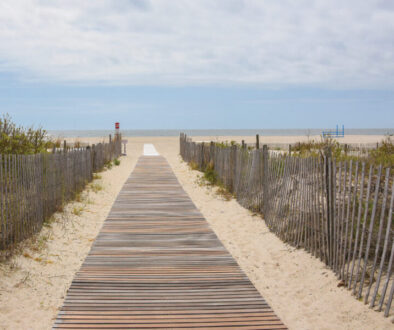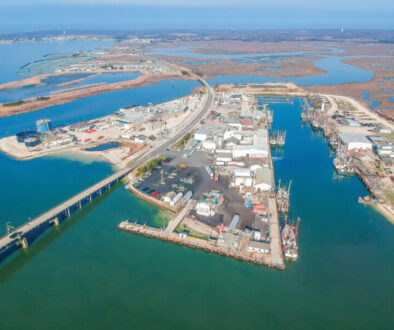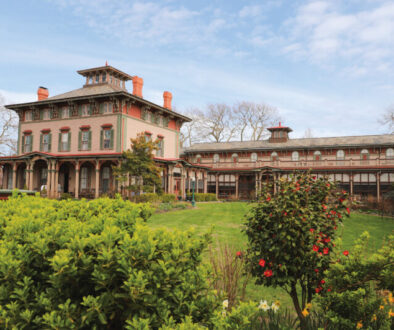The Scenic Route: Cruising the Garden State Parkway

Life in the 21st century is on the move. Literally. There are 276 million registered vehicles in the U.S. and 44 percent of them are cars. Highways of every sort crisscross the country top to bottom. We are a people on the go, and most of our going takes us onto highways. My own experience with driving highways leaves me avoiding such chaotic, fast-moving speedways whenever possible. Except one. Follow this highway spilling down the east side of New Jersey and it’ll take you through pine forests and patches of wildflowers, over broad sparkling estuaries, across winding creeks, rivers, broad bays, and sprawling marshes. This carefully thought-out road will safely drop you off at the best islands the Jersey shore has to offer, including its last (and my favorite) exit, Cape May. Such is the brilliant design and intention of the Garden State Parkway. It was and is deemed one of safest and most beautiful highways in the country, and its visionaries pulled out all the stops.
As America was riding the wave of the Industrial Revolution into the 20th century, the steady swell of European immigrants flooding Philadelphia and New York City overflowed into the open farmlands, forests, and growing commerce centers of neighboring New Jersey. The state expanded in every direction, and before long steam-powered ferries, trains, and bridges for motorized cars connected the mainland to the once-isolated and uninhabited barrier islands stretching down Jersey’s coastline. “The Jersey Shore” was born.
By the 1940’s it became clear there was a need for a new extensive roadway to move a growing population of motorists and seashore-bound tourists around the state. New Jersey Governor Walter Evans Edge, along with Secretary of Highways Harold Griffin, launched the idea to thread a superhighway south along the eastern edge of the state from the New York-New Jersey state line through ten rapidly developing counties to the very tip of Jersey’s peninsula. The project required not only the most ingenious consultants, designers, and engineers, but a whole lot of cash and a willing public to back up such an intrusive and temporarily inconvenient build. The go-ahead came in 1946, but delays bogged down the project until the State Legislature created the New Jersey Highway Authority in 1952. This ensured the necessary funding of the $330-million Parkway through collected toll revenues.
With financial backing secured, the Parkway dream team pressed on, their sights set on a roadway with “the speed and convenience of a modern superhighway combined with the beauty and relaxing experience of a country road.”
Superhighway? Relaxing country road? Seems like a contradiction. Yet this was the vision that Gilmore Clark, a landscape architect and engineer, was hired to create. Clark had spent his whole career designing brilliant landscapes in the midst of challenging city and urban sprawl. His work with the New York City Parks Department taught him how to weave his green architecture around what he could not change or move. He honed his skills developing the Central Park Zoo and Conservatory Garden, as well as Riverside Park and two World Fairs. When he finally landed at the collective drawing table in New Jersey, he brought with him his recent work experience on the Pennsylvania Turnpike and Connecticut’s Merritt Parkway. The speed of one and the beauty of the other helped do what Clark did best. The parkway project was as intriguing and inviting as any young creative could ask for. This river of a road would weave its way through and around State Parks and preserves already established, with the long chain of extraordinary barrier islands and broad wetlands running parallel alongside the whole corridor.

This Parkway would move a growing populous towards the shore points with new innovative safety designs to provide as smooth a ride and as safe a journey as possible. All entrances and exits from the driving lanes are restricted to 101 specific and current locations. It was determined there would be no cross-traffic along the entire route; 371 overpasses and underpasses would allow free and uninterrupted flow, eliminating all stop signs and traffic light delays. Two one-way separate roadways would divide the traffic heading south from the traffic heading north. Each would consist of two or three 12-foot wide lanes separated by simple painted white lines. A broad center island averaging at least 100 feet in width would separate opposing streams of traffic and eliminate head-on collisions. The center island would be planted with native trees and shrubs to diffuse the glare of headlights of oncoming traffic. Where lanes converge in some areas as narrow as 30 feet between opposing traffic, landscaped berms would block the view and blinding glare.
The paved surface area was designed to be smooth and regular for the long gradual acceleration and deceleration on and off roads, interchanges, and service areas. “Singing” shoulders or “rumble strips” were incorporated to keep drivers alert and from straying off the roadway. Slightly sloping, broad and unobstructed shoulders allow disabled vehicles to disengage safely and easily from the fast-moving stream of traffic. Beyond the shoulders, drainage basins were designed to be shallow, eliminating ditch-like cuts often present on other highways.
This meandering road’s built-in curves are intended to keep motorists alert, eliminating monotonous hypnotic straightaways that create drowsiness. The vertical curves and road grade are kept to a maximum of three percent.
A watchful eye towards the future was also built into the long-range vision of this road. Realistically, the Parkway would need to have some flexibility to expand over time. It was clear that this area of the state, with its wide-open accessibility to its barrier islands, would need to address the colossal amount of increased traffic heading its way. Extra-wide shoulders and broad medians would provide ground to expand lanes as needed. Many of us had front-row [car] seats to the downing of trees during the widening project in 2008 between Exits 30 and 80. There are times when the demand encroaches beyond those perimeters into fragile habitats and along people’s backyards. Such is the cost and reality we find ourselves in today—and down the road, as the planet bulges in all directions.
Coupled with its safety features this new superhighway would offer a unique infused experience. Lining up the cut through the state, the Parkway was to resemble a 172-mile-long state park, meandering alongside and through some of the most pristine and preserved areas New Jersey offers. A park is thought to be static, rooted in earth with defined boundaries. It doesn’t move. But this route through the state would mimic park-like aesthetics all along its course. With all things simplified and nature amplified there would be nothing to distract drivers from the variety of habitats and landscapes this road would offer.
Signs resemble state park versions, with simple green backgrounds, white lettering and wooden posts. Guardrails are either natural wood or painted brown metal. No billboards are permitted anywhere. Service buildings and police barracks are compatible with the “New Jersey Colonial” single-story designs made of either brick or wood.

Picnic areas were dispersed in ten different locations along its route. Secluded little oases set among tall shade trees provided a reprieve from hot cars that had yet to be outfitted with cool climate-control interiors. Grills were provided for cookouts, grassy lawns for packed picnic baskets, and the areas were topped off with running water and bathrooms. Fast-forward into the inventions of 21st-century cars, such stops were deemed unnecessary and these little respites eventually grew vacant, morphing into Parkway maintenance yards. Only two picnic areas remain today: John B Townsend Shoemaker Holly Picnic Area near Exit 17 and Telegraph Hill next to the PNC Bank Arts Center off Exit 116.
Starting at the state line from New York, the Garden State Parkway blazed a difficult trail through an already dense jungle of development that was well on its way long before the Parkway ever broke ground. Known as the “Metropolitan Section,” North Jersey is a buzz of New York suburbs, industry, major airports, and the wild heartbeat of Manhattan flanking Jersey’s eastern shoreline. But once up, up, up, and over the impressive 15-lane Driscoll Bridge with the Raritan River below, the Parkway funnels you down into its “Shore Section.” Suddenly this superhighway takes on its intended country-road feel; as the surroundings grow green and dense suburbia transitions into wide open meadows and estuaries. The natural elements do something so subliminally subtle. Undetectable on some visceral level, we relax a little deeper into our seats.
Water, water everywhere. All along the Parkway you encounter the beauty of watery worlds. The smallest trickle of brooks and streams as well as vast bays, rivers, and inlets running beneath its many overpasses and bridges. Little bursts of sun sparkles reflecting off the water’s glassy surface blink—magical. Every now and then there’s a glimpse of the expansive Atlantic Ocean running parallel to the east. Toes wiggle in anticipation of its salty, cold swirl.
Although little New Jersey has been saddled with the unflattering title of “densest state in the country,” it’s quite impressive how much land remains open and preserved in this Garden State, and much of it you pass through traveling north-south on the Parkway—our so-called “park along the Parkway.”
This bustling country road takes us through and around our major State Parks—Cheesequake, Allaire, Double Trouble, and Bass River State Forest. Thousands upon thousands of acres of ancient woodlands, coastal mountains, water sheds, swamps, wetlands, and valuable ecosystems are protected within these sacred perimeters. And if we let ourselves visually slow down some and look deep into those woods as we’re zippin’ by, we may well imagine Lenape Indians traveling well-worn foot paths towards the sea. Faces of wide-eyed immigrants establishing small settlements and sea shanty ports. Ancestors with preserved histories and remnants left behind are part of the many state parks treasures along the way. This “country road” truly was such a reality not so long ago.
Wildlife and wildflowers keep pace with the road. Deer graze at dusk. Skunk, fox, opossum and raccoons dip in and out of sight, broad patches of brightly colored wildflowers wave to us. The Garden State Parkway Wildflower Planting Program answered the call of Lady Bird Johnson’s plea for adorning the country with flowers anywhere and everywhere. Now four decades later, the wildflower program and highway gardens are thriving. These brilliant mixes of wildflower seed are now available to purchase for your own yards, spreading Lady Bird’s vision even farther. [Visit gspwildflowers.com]

Fields of wildflowers not only paint landscapes but they also feed a host of birds and insects along the way. All the while you’re cruising over land, just above you the Atlantic Flyway guides all manner of migrating birds, insects, butterflies, dragonflies and bees north and south. It is believed the green corridor of the Parkway has been adopted and adapted into the Flyway’s visual path of navigation. Eagles, hawks, owls, crows, and buzzards circle. Flocks of songbirds pass over as silent as water ripples. Herons come in for a landing to forage along creeks and wade through estuaries. The wild world travels along with us.
As the road winds down and funnels into the state’s peninsula, the entire east side of the Parkway opens out to the Cape May Wetlands that consist of a whole cascade of sounds running between the Parkway and the long link of barrier islands beyond. You really cannot ignore this section no matter how distracted you might be. Corson and Carson Sound. Townsend, Sites, Jenkins, and Great Sound. Richardson and Grassy Sound with Jarvis Sound ushering us off the Parkway and over the bridges into Cape May—Jersey’s last stop before we reach the shores of the Delaware Bay.
There are those of us who dip in and out of the Parkway with short stints coming and going. There are others who travel its whole length top to bottom en route to points north and south of Jersey. Whatever time spent on this gem is a gift. Consider the many minds, hearts, hands, and sweat that designed and built this amazing and beautiful road and enjoy the journey it offers. Even if the traffic slows, the sceneries remain. Set your iPhones aside. Look out. Look up. Look around. Take it all in. Crack a window or two and let that piney-briny-salty scent waft in. Fully experience and celebrate this meditation in motion that still delivers what it set out to do now 73 years later.



